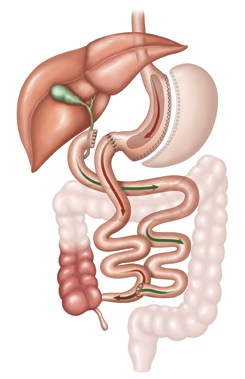Laparoscopic Bilio-Pancreatic Diversion with Duodenal Switch (BPD/DS)

The laparoscopic bilio-pancreatic diversion with duodenal switch (BPD/DS) is somewhat similar to the gastric bypass. However, instead of a small stomach pouch, the surgeon creates a sleeve-shaped tubular stomach. The surgeon then attaches the final section of the small intestine to the stomach sleeve /tubular structure via sewing and stapling.
The small intestine absorbs calories and nutrients. By bypassing all but the last section of the small bowel, ensures that fewer calories are absorbed, but also greater malabsorption symptoms are experienced.
The first step of the DS operation is to do perform/ create a sleeve gastrectomy, only with a larger diameter bougie. The intestinal bypass starts distally at the ileo-caecal valve, with the common channel being created to be 75-100cm from the ileo-caecal valve.
The mesenteric spaces and Petersen’s space should be closed with non-absorbable sutures to avoid any internal herniation, which could in turn lead to small bowel obstruction. If you develop upper or left sided abdominal pain, please contact our Clinic ASAP- for early intervention as this is a medical emergency! We do NOT want the blood supply to that part of the small intestine to become compromised, as this may result in surgical removal of that part of the small intestine.
Mesentery=continuous set of tissues located in your abdomen; it attaches your intestines to the wall of your abdomen and holds them in place
Small bowel obstruction= means a partial or complete blockage of the small bowel. This prevents digested products (food, liquid, gas etc) from passing through to the large intestine and then eventually out via the back passage (anus).
Both short term and long-term weight loss following DS exceeds that of any other operation. The benefits especially for patients with metabolic syndrome are well documented.
However DS patients will need adhere to strict and strong vitamin supplementation including the fat soluble vitamin (A,D,E and K).
Recently the DS was modified to the SADI (Single Anastomosis Duodeno - Iliostomy) is a different type of bypass reconstruction than the traditional DS. The long- term results of the SADI other operations are eagerly awaited.











